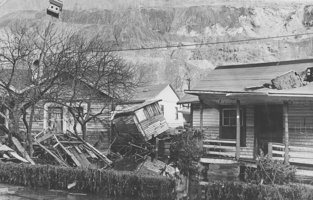 | Back to e-WV
| Back to e-WV
 The West Virginia Encyclopedia
The West Virginia Encyclopedia
 | Back to e-WV
| Back to e-WV
 The West Virginia Encyclopedia
The West Virginia Encyclopedia

One of the country’s worst mining-related disasters occurred February 26, 1972, on Buffalo Creek in Logan County. At approximately 8 a.m., a coal waste dam collapsed on the Middle Fork of Buffalo Creek, releasing 132 million gallons of water, coal refuse, and silt into the narrow mountain valley. Within two minutes, the black wave plowed downstream into two other coal waste dams and a burning coal refuse pile. In the next three hours, the rampaging water demolished or partially destroyed the 17 communities downstream. Saunders was hit first, followed by Pardee, Lorado, Craneco, Lundale, Stowe, Crites, Latrobe, Robinette, Amherstdale, Becco, Fanco, Riley, Braeholm, Accoville, Crown, and Kistler.
In the end, 125 people, including entire families, were killed; 1,000 people were injured; 507 houses and 44 mobile homes were destroyed, 273 houses were severely damaged, and 663 houses were partially damaged; and 4,000 of the 5,000 residents of Buffalo Creek were left homeless. Residents of the closely knit coal towns were dispersed. Some eventually rebuilt, but others never returned. Some communities vanished.
Buffalo Mining Company, a division of the Pittston Company, owned and operated the three coal waste dams. The dams were constructed to hold coal waste and water from the company’s coal preparation plant on Buffalo Creek, about one-half mile north of Saunders.
At the time, the state Public Service Commission was responsible for overseeing impoundments that blocked streams. A state investigation found that neither Pittston nor the previous owner that had built a dam on Middle Fork had submitted dam construction plans to the PSC for approval. For years, Buffalo Creek residents had been concerned about whether the dams posed a danger to them. Surveys and inspections by officials from the U.S. Geological Survey and the state Department of Natural Resources had concluded that the dams might be susceptible to washouts.
After the flood, state and federal investigations found that the flood was caused by improper construction of the coal waste dams. The Governor’s Ad Hoc Commission of Inquiry found that ‘‘The Pittston Company, through its officials, has shown flagrant disregard for the safety of residents of Buffalo Creek and other persons who live near coal-refuse impoundments.’’ Pittston officials blamed the flood on the 3.7 inches of rain that fell in the three days before February 26, and called the disaster ‘‘an act of God.’’
Six hundred and forty five survivors and family members of flood victims filed suit against Pittston. In 1974, the suit was settled for $13.5 million, an average of $13,000 for each plaintiff after legal fees. The state of West Virginia also filed suit against Pittston, asking for $100 million to compensate it for damage to state property and losses to residents. On January 14, 1977, Governor Arch Moore accepted a $1 million settlement in the suit. In 1988, after years of legal procedures, the state was forced to reimburse $9.5 million to the U.S. Army Corps of Engineers for flood recovery work.
The Buffalo Creek Flood prompted Congress and the West Virginia legislature to pass new laws regulating dam construction and maintenance.
e-WV presents West Virginia Public Broadcasting on Buffalo Creek
Written by Nancy Ray Adams
Erikson, Kai T. Everything in its Path. New York: Simon & Schuster, 1976.
The Buffalo Creek Flood and Disaster. Official Report from the Governor's Ad Hoc Commission of Inquiry, August 1972.
Lindsay, Cliff, Steve Hoyle & John Fredland. The Buffalo Creek Disaster. Joseph A. Holmes Safety Association Bulletin, (July-August 2002).